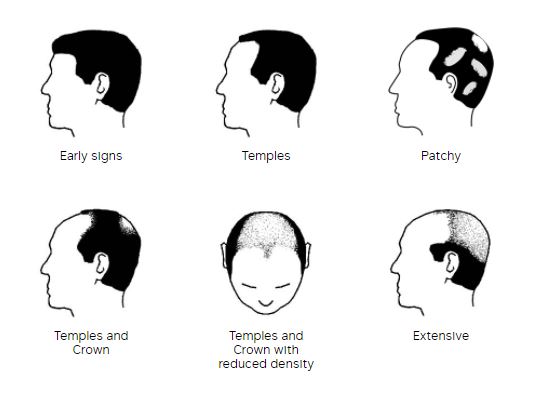A visual guide denoting 7 different stages of hair thinning; it can be helpful in determining the most appropriate treatment regime. Here we take a deep dive into this tool, exploring how it is utilised by our Trichologists to help accurately diagnose Male Pattern Hair Loss.
What is the Hamilton-Norwood Scale?
In 1951, James Hamilton pioneered a scale to measure the stages of male pattern baldness, after studying more than 300 males experiencing hair loss1. The scale focused on ‘frontoparietal and frontal recessions and frontal thinning’.
Fast forward to 1975, and after studying patterned hair loss in 1,000 males, Dr. O’Tar Norwood greatly improved this scale2. He observed that thinning begins in the temples as well as the crown/vertex, and slowly progresses to the entire top of the scalp, and thus based his classification on this pattern.
1 | Medical News Today
2 | National Center for Biotechnology Information (NCBI)
Today, the Hamilton-Norwood Scale remains the only scale used for the classification of Male Pattern Hair Loss. Akin to a visual classification guide, it features seven images each denoting different extents of hair loss, categorised by a scale of 1 to 7. While every individual case of hair loss is different (and cases can widely vary) those experiencing Male Pattern Hair Loss tend to lose their hair in one of a few common patterns throughout their lifetime.
It is necessary to classify both pattern and density, because Male Pattern Hair Loss can manifest as changes in one or the other, or both. For example, a man may retain his hairline, but experience general hair thinning, while another may notice the hairline receding, but not especially see reduced density.
The scales provide a means of documenting what a Client’s hair loss was like when they started treatment, and then at later points during the treatment plan. No system of classification is perfect, which is why photographs can also be helpful. The stages of hair loss included in the Hamilton-Norwood Scale range from receding at the hairline and temples, to balding at the vertex (the crown).
The Stages of The Hamilton-Norwood Scale
Stage 1
No significant hair loss or recession of the hairline.
Stage 2
There is a slight recession of the hairline around the temples.
Stage 3
The first signs of clinically significant balding appear. The hairline becomes deeply recessed at both temples, resembling an M, U, or V shape. The receded areas may be thinner or denuded.
Stage 3 vertex
The hairline stays at stage 3, but hair also begins to thin on the top of the scalp (the vertex).
Stage 4
The hairline recession is more severe than in stage 3, and there is sparse hair or no hair on the vertex. The two areas of hair loss are separated by a band of hair that connects to the hair remaining on the sides of the scalp.
Stage 5
The two areas of hair loss are larger than in stage 4. They are still separated, but the band of hair between them is narrower and sparser.
Stage 6
The balding areas at the temples start to join with the balding area at the vertex. The band of hair across the top of the head is gone or sparse.
Stage 7
The most severe stage of hair loss, only a band of hair going around the sides of the head remains, with very sparse or no hair in the top region.

Is the Hamilton-Norwood Scale important?
The Hamilton-Norwood Scale is a useful source of reference, but other factors should also be considered. At Philip Kingsley, we believe that hair density is also key when it comes to making a hair loss diagnosis. We therefore take this into account when recommending the best treatment options for you. The factors we consider, include:
- Pattern – The traditional way of classifying and prescribing treatment.
- Density – We recognise density is just as important as the hair loss pattern, so we consider this every time we recommend treatment.
- Age – Early thinning may require a different approach to hair thinning that starts later on in life, since early hair thinning denotes a stronger genetic predisposition.
- Scalp health – To maximise results, we assess your scalp health and recommend a regime suited to attaining the optimum scalp environment.
- Personal preference – Consistency is key to successful hair loss treatment, so we want to ensure we recommend a treatment that will suit your lifestyle and you will easily be able to stick to from the first use (and into the future).
- Side effects and risk levels – We will recommend the best product for you, aligning with your personal circumstances and with the lowest risk possible.
Treatment for Male Pattern Hair Loss
We understand the importance of an individualised approach when it comes to treating hair loss — after all, there is no one-size-fits-all solution. Over the past 60 years, our expert Trichologists and bespoke Clinic formulations have helped thousands of people on their hair loss journey.
We are here to help, both in-person at our Clinic and virtually via video Consultation. Find out which service is ideal for you by completing our quick online assessment.
Concerned about hair loss?
Recieve a tailored male pattern hair loss plan in 2 minutes with our quick questionnaire.






